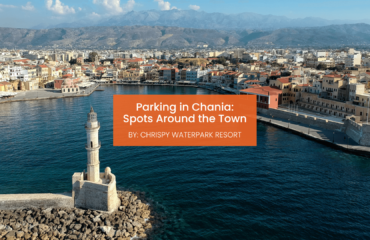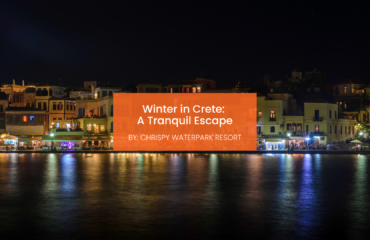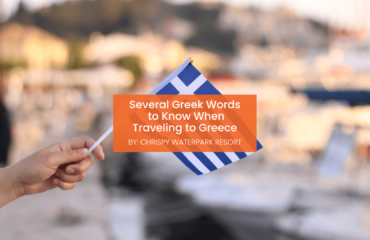Is it your first time visiting Crete? Then this article is for you! Crete, the largest of Greece’s islands, is a gem in the Mediterranean with a rich tapestry of history, culture, and natural beauty. Stretching from the azure waters of the Aegean Sea to rugged mountain ranges, Crete offers a diverse array of experiences for travelers. Whether you’re an adventurer, a history buff, or simply seeking relaxation, Crete has something special to offer. This guide will help you navigate the island’s top destinations, activities, and practical tips for an unforgettable visit.
Visit Crete and explore our rich heritage!
Historical and Cultural Highlights
1. Heraklion and the Palace of Knossos:
To begin with, Heraklion, Crete’s capital, is the island’s bustling heart and a gateway to its storied past. The city is home to the Heraklion Archaeological Museum, which houses an extensive collection of Minoan artifacts. A short drive away is the Palace of Knossos, the largest and most significant Minoan site on the island. Dating back to the Bronze Age, Knossos is renowned for its complex layout and colorful frescoes, including the famous depiction of the Minotaur.
2. Rethymnon:
Rethymnon is a charming town known for its well-preserved Renaissance architecture. Its old town is a labyrinth of narrow streets lined with Venetian mansions, Ottoman minarets, and neoclassical buildings. Key sights include the Fortezza Castle, which offers panoramic views of the town and sea, and the picturesque Venetian harbor.
3. Chania:
Chania, with its beautiful Venetian harbor, is one of Crete’s most picturesque cities. The harbor is a mix of historical buildings, cafes, and shops. The nearby Maritime Museum and the Archaeological Museum provide further insights into Crete’s rich history. Don’t miss a stroll through the old town’s narrow alleys, which are filled with local shops and eateries.
In addition, here you will find the ultimate guide with things to do in Chania with kids.
Natural Wonders and Outdoor Activities in Crete
1. Samaria Gorge:
For outdoor enthusiasts, the Samaria Gorge is a must-visit. Specifically, located in the White Mountains of western Crete, this 16-kilometer-long gorge offers a spectacular hike through rugged terrain and stunning landscapes. The trail, which descends from the Omalos Plateau to the village of Agia Roumeli, takes about 5-7 hours to complete. Along the way, you’ll encounter rare wildlife, including the Kri-Kri wild goat.
2. Elafonisi Beach:
In addition, Elafonisi Beach, located on the southwestern coast, is famous for its pink sand and crystal-clear waters. The shallow lagoon makes it ideal for families and those looking to relax. The beach’s unique coloration comes from crushed shells, and its idyllic setting is perfect for sunbathing and swimming.
3. Balos Lagoon:
Balos Lagoon, accessible by boat or a challenging hike, is another natural wonder. The lagoon features a stunning mix of turquoise and blue waters, surrounded by white sand and rocky outcrops. The view from the hilltop is breathtaking, and the area is excellent for swimming and snorkeling.
Visit Crete for local Cuisine and Wineries
Specifically, Crete’s culinary scene is a delightful exploration of traditional Greek flavors with a local twist. The island’s cuisine emphasizes fresh, local ingredients, including olives, cheeses, and seafood.
1. Traditional Dishes:
Try local specialties such as moussaka (a baked casserole of eggplant, potatoes, and minced meat), dakos (a Cretan salad with barley rusk, tomatoes, and feta), and kalitsounia (small pastries filled with cheese or herbs). Don’t miss a taste of Cretan honey and olive oil, which are integral to the island’s gastronomy.
2. Wineries:
Crete is also home to several excellent wineries. The region of Apokoronas, near Chania, is famous for its wine production, including varieties such as Vidiano and Kotsifali. Specifically, many wineries offer tours and tastings, allowing you to sample local wines and learn about the island’s viticultural traditions.
Remember to check the hotel’s Instagram profile and website so you won’t miss out on the upcoming fun.
Practical Tips for Travelers
1. Getting Around:
Crete’s public transportation includes buses that connect major towns and attractions. However, renting a car is highly recommended for greater flexibility and access to more remote areas. Roads are generally well-maintained, but be prepared for some narrow and winding routes, especially in mountainous areas.
2. Best Time to Visit:
The best time to visit Crete is during the spring (April to June) or autumn (September to October). During these seasons, the weather is pleasantly warm, and the island is less crowded. The summer months (July and August) can be very hot, especially in inland areas, and attract more tourists.
3. Language and Currency:
Greek is the official language, but English is widely spoken in tourist areas. The currency is the Euro (€). Moreover, we accept Credit and debit cards, but it’s always a good idea to carry some cash, especially in smaller villages.
4. Safety and Health:
Crete is generally a safe destination, but you should always take standard precautions. Also, tap water is safe to drink in most areas. Also, we recommend travel insurance for any unforeseen circumstances.
Conclusion
In conclusion, visit Crete for an unforgettable experience. The island is a captivating destination that seamlessly blends its ancient history with natural beauty and vibrant culture. From exploring the ruins of the Minoan civilization to hiking through stunning gorges and indulging in delicious local cuisine, the island offers a diverse range of experiences. Whether you’re planning a leisurely escape or an active adventure, Crete promises a memorable journey. So, pack your bags and get ready to discover the enchanting allure of this Mediterranean paradise.







